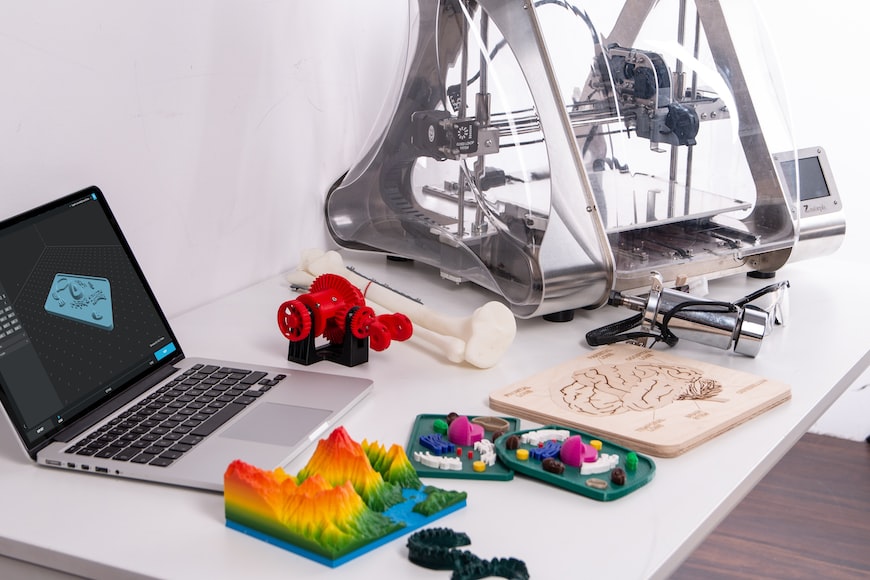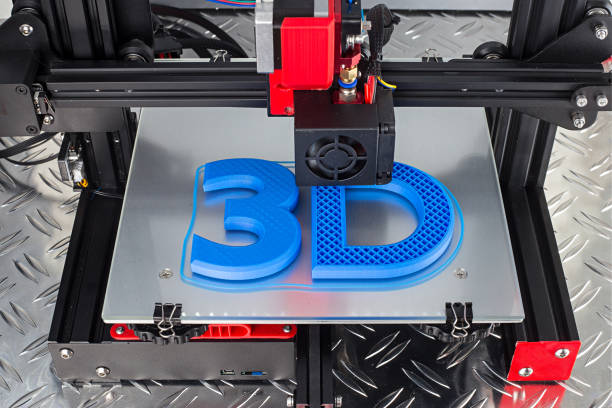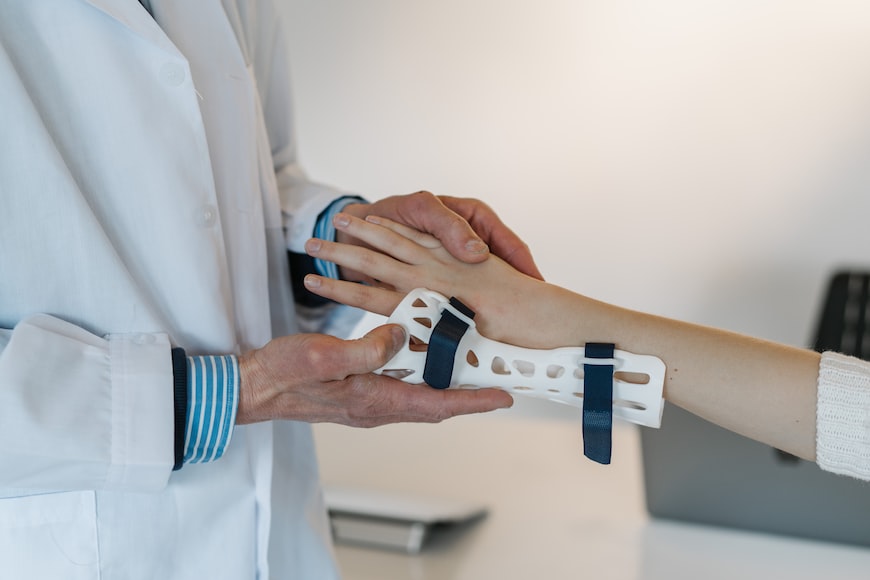This article will provide a brief guide to 3D printing materials. We will include the following:
3d print material considerations
Types of 3D printing processes
PLA
ABS
Nylon
Metals, Titanium, Stainless Steel, Aluminium, Copper, Tungsten.
In this article we are going to take a brief look at 3D printing materials. We will examine what materials can be 3D printed and what they are often used for. While there are a wide range of different materials, we will look at some of the most popular choices. We choose some based upon their mechanical properties. While others because of their ease of printability or their smooth surface textures. However, in reality, in a home use environment we choose the materials that we have in stock, and most of us will likely just have PLA! If you are outsourcing the printing to Prototype Finder, your choices of material are much broader.
Design engineers often use 3D printing to create a functional prototype or visual model of their product. It is desirable for the designer to be able to print the part in a material that will simulate the actual material used in the finished part. 3D printing materials are ever evolving and improving to provide improved mechanical properties and appearance. Materials for 3D printing range from plastic, which is the most commonly used, through metal to concrete for building large structures. Let’s look at some of the options when it comes to 3D printing material below. Including some plastic materials, and metals, but first we should consider the processes used.
Are you looking for cheap 3D printing or the strongest 3D printing material? What are materials that you should consider? They all have their different advantages. Some being tough and sturdy, others cost-effective and flexible.

3D printing has come a long way in the last 30 years and is now affordable for hobbyists to have their own machine at home. The home use machines are typically FDM type which means Fused Deposition Modelling. This process in simple terms lays a hot cord of material onto a bed in a continues stream. The material is forced through a hot nozzle that will melt it just before it is deposited on to the previous layer. The part is built layer by layer, depositing a layer of hot material that is fused to the previous layer. These machines are affordable and relatively easy to use. It is possible to buy machines that can build sturdy large parts with only a short learning curve. There is a large community that provides support and helps with trouble shooting and learning.
Resin printers are relatively new for home use but are available and very affordable for the base models. These machines are similar to the original stereolithography machine that were first used for 3D printing in the mid 1980’s. The machines have a bath of photo polymer resin that solidifies when exposed to UV light. Like all 3D printers the printed part is built in layers one by one. The layer thickness determines the amount of detail in the finished part. With resin printers, the level of detail is much finer and they are faster. However, they do have a couple of down sides, they can be messy, and the resin does have a strong odor and the resin is more expensive than FDM (approx. 2.5 X). Also, the parts still need cleaning after printing and curing by further exposure to UV light. Resin printers are considered harder to use than FDM machines. If you are new to 3d printing you should consider carefully which type of machine suits your need best. Resin printed parts are more accurate and have more detail, but more difficult to use and material is more expensive.
3D printing of metal parts is a process that is costly and not suitable for hobbyist printing. The machines are very expensive, printing is slow, and the build envelope is small, meaning you can only build relatively small parts in metal. In 2021 the patents which were held by Stratasys expired meaning other manufacturers could develop machines using technology that is no longer exclusive to the original pioneers of the process. This means the technology will become more widespread and costs will fall dramatically in the coming years. The process is different to FDM or Resin printers of course due to the different materials but has some similarities. In metal printing the base material is a fine powder, it is sintered using high power lasers. The part is built up layer by layer just like FDM and Resin printers. Metal printed parts are a very important part of the future of aviation and other high-tech industries. Complex and highly detailed parts that are impossible to machine can be printed. Internal aircraft engine components are now printed and used daily on commercial flights.
There are other 3D printing processes that have similarities to the three above mentioned. SLS is a way to fuse plastic powder together to make plastic parts in a similar way to metal printing. Resin printers can use either an LCD screen or lasers is another example of variations. Some metal printers use a process of depositing particles of metal which is heated to a molten state and sprayed locally in a controlled manner. It is known as (EMB) Electron Beam Melting. Very large machines are being used to 3D print homes in concrete. There are materials used for FDM machines that have some metal powder inside, so the parts take on a metallic appearance. There are also institutions that are developing machines that can print metal and plastic parts in one build! This means that we could 3D print an assembly from metals and plastics which will be amazing when the technology becomes mainstream. It is only a matter of time!
There are many different types of printing processes. From FDM, resin, metal and many others. Each with a host of unique benefits. Be careful when choosing which is best for your specific needs.

Acrylonitrile Butadiene Styrene or ABS for short. This is the plastic that makes the famous Lego blocks. It can be a great choice for 3D printing toys, as it is tough, and great at retaining its colors. It is not suitable for extended use outdoors. ABS is a solid choice for making functional models, it is very popular for production injection molding. When it comes to 3D printing all materials have their limitations and inherent problems. With ABS the main problems are warping and shrinkage, which can lead to a part that performs poorly. ABS is a good choice for visual models that do not require good dimensional accuracy. ABS dimensions and warping can be better controlled when injection molded.
PLA known as Polylactic Acid, is biodegradable unlike ABS. This 3D print material is made from renewable raw materials, like corn starch and it is one of the most popular materials for printing. It is a good choice of material for general use 3D printing. This is because of its ease-of-use, dimensional accuracy and lower costs. But it has some downsides. It is not a plastic that is food-safe and can be brittle when used for printing. This makes it a good choice for painted miniatures and general 3D printing.
What materials do you need for your next 3D printed product? Some are great for building prototypes. While others work best for intricate interlocking parts or 3D printed toys. Such as figurines and miniatures.

Nylon is also known as Polyamide or PA. This is a popular material amongst the plastics industry because of its toughness, high tensile strength (can hold weight without breaking) and flexibility. Nylon is fairly new to 3D printing, but it is popular because of its mechanical properties. This 3D printer material is also inexpensive and resistant to most common chemicals. There are food grade nylon blends that are commonly used for injection molding, but it is not food safe for 3D printing and is toxic. If you wish to print food related products do not allow them to come into contact with food that will be consumed.
3D printing materials aren’t only used to 3D print toys. They also create tools, jewellery, gifts, furniture and prototypes!

Titanium, stainless steel, aluminium, copper and many more materials are all possible to be 3d printed if the material is available in a suitable fine powder form. In theory any metal that does not burn when melted at a high temperature can be 3d printed if the powdered form is available. Commercially available metals for metal 3D printing are Titanium, Aluminium, Stainless Steel and Copper.
In this article we have briefly covered 3D print materials and 3D printing processes.
Are you looking for one of the best plastic prototype manufacturing companies out there? Choose Prototype Finder. We here at Prototype Finder know a great deal about 3D printing materials and the processes involved. This is because we are a prototype manufacturing and injection molding company! We have worked with plastic and 3D printed parts for many years. We prototype plastic and metal parts and can provide low to medium volume injection molded parts.
Should your next project include 3D printer materials? Or are you looking for some plastic material quotes? If you are not sure what to do next, contact us and request a quote! Or you can indeed ask us any questions and we will be more than happy to assist in any way we can!
If you enjoyed this article make sure you take a look at some of our other posts on many other materials and topics. Including Prototype Injection Molding, Companies that Build Prototypes and Blow Molding 101.
Categories: BLOG
Tags:
Leave a Reply

Recent Posts
Comparative Analysis of Titanium and Aluminum in Manufacturing Blow Molding 101: What you Must Know Prototype Fabrication: The Critical Breakdown CNC 101: Everything you Need to Know about this Manufacturing Process Turning and Milling Stock: Everything you Must Know Overmolding: The Best Choice for your Next Product?Categories
Comparative Analysis of Titanium and Aluminum in Manufacturing Blow Molding 101: What you Must Know Prototype Fabrication: The Critical Breakdown 3D Printing Materials: 5 Ultimate Choices Overmolding: The Best Choice for your Next Product? Galvanized Steel vs Stainless Steel: Which is the Best MetalRelated Posts